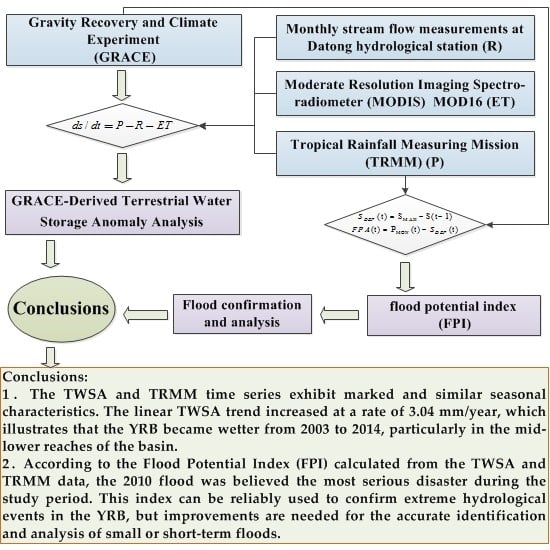Assessing Terrestrial Water Storage and Flood Potential Using GRACE Data in the Yangtze River Basin, China
Abstract
1. Introduction
2. Materials and Methods
2.1. Study Area
2.2. Data
2.2.1. GRACE Data
2.2.2. TRMM Data
2.2.3. Ancillary Data
2.3. Methods
2.3.1. Evaluation of GRACE-Derived Total Water Storage Changes
2.3.2. Flood Potential Index
2.3.3. STL Decomposition
3. Results
3.1. GRACE Data Analysis and Validation
3.2. GRACE-Derived Terrestrial Water Storage Anomaly Analysis
3.3. Flood Confirmation and Analysis
4. Discussion
4.1. GRACE Data Evaluation
4.2. GRACE-Derived TWSA Analysis over YRB
4.3. Flood Analysis Using FPI over YRB
4.4. Hydrological Evaluation Based on GRACE Data
5. Conclusions
- The TWSA and TRMM time series exhibit marked and similar seasonal characteristics, with summer peaks and winter troughs, which demonstrate that precipitation is likely the dominant cause of changes in the TWSA. The linear TWSA trend increased at a rate of 3.04 mm/year, which illustrates that the YRB became wetter from 2003 to 2014, particularly in the mid-lower reaches of the basin, where the maximum linear TWSA trend was 20.08 mm/year.
- According to the Flood Potential Index (FPI) calculated from the TWSA and TRMM data, the 2010 flood was believed the most serious disaster during the study period, with the biggest FPI of 0.36, discharge of 93.32 mm, and rainfall of 209.03 mm, the percent of bigger than monthly mean discharge and precipitation also remain the larger value, 37.95% and 19.44%, respectively. This index can be reliably used to confirm extreme hydrological events in the YRB, but improvements are needed for the accurate identification and analysis of small or short-term floods.
Acknowledgments
Author Contributions
Conflicts of Interest
References
- Long, D.; Yang, Y.; Wada, Y.; Hong, Y.; Liang, W.; Chen, Y.; Yong, B.; Hou, A.; Wei, J.; Chen, L. Deriving scaling factors using a global hydrological model to restore grace total water storage changes for China’s yangtze river basin. Remote Sens. Environ. 2015, 168, 177–193. [Google Scholar] [CrossRef]
- Famiglietti, J.S. Remote sensing of terrestrial water storage, soil moisture and surface waters. State Planet Front. Chall. Geophys. 2004, 197–207. [Google Scholar] [CrossRef]
- Tapley, B.D.; Bettadpur, S.; Ries, J.C.; Thompson, P.F.; Watkins, M.M. Grace measurements of mass variability in the earth system. Science 2004, 305, 503–505. [Google Scholar] [CrossRef] [PubMed]
- Andersen, O.B.; Seneviratne, S.I.; Hinderer, J.; Viterbo, P. Grace-derived terrestrial water storage depletion associated with the 2003 european heat wave. Geophys. Res. Lett. 2005, 32. [Google Scholar] [CrossRef]
- Frappart, F.; Ramillien, G.; Ronchail, J. Changes in terrestrial water storage versus rainfall and discharges in the amazon basin. Int. J. Climatol. 2013, 33, 3029–3046. [Google Scholar] [CrossRef]
- Tong, J.; Qiang, Z.; Deming, Z.; Yijin, W. Yangtze floods and droughts (china) and teleconnections with enso activities (1470–2003). Quat. Int. 2006, 144, 29–37. [Google Scholar] [CrossRef]
- Xie, N.; Xin, J.; Liu, S. China’s regional meteorological disaster loss analysis and evaluation based on grey cluster model. Nat. Hazards 2013, 71, 1067–1089. [Google Scholar] [CrossRef]
- Joshi, N.; Baumann, M.; Ehammer, A.; Fensholt, R.; Grogan, K.; Hostert, P.; Jepsen, M.; Kuemmerle, T.; Meyfroidt, P.; Mitchard, E.; et al. A review of the application of optical and radar remote sensing data fusion to land use mapping and monitoring. Remote Sens. 2016, 8, 70. [Google Scholar] [CrossRef]
- Wang, S.; Zhou, F.; Russell, H. Estimating snow mass and peak river flows for the mackenzie river basin using grace satellite observations. Remote Sens. 2017, 9, 256. [Google Scholar] [CrossRef]
- Famiglietti, J.S.; Lo, M.; Ho, S.L.; Bethune, J.; Anderson, K.J.; Syed, T.H.; Swenson, S.C.; de Linage, C.R.; Rodell, M. Satellites measure recent rates of groundwater depletion in california’s central valley. Geophys. Res. Lett. 2011, 38. [Google Scholar] [CrossRef]
- Long, D.; Shen, Y.; Sun, A.; Hong, Y.; Longuevergne, L.; Yang, Y.; Li, B.; Chen, L. Drought and flood monitoring for a large karst plateau in southwest china using extended grace data. Remote Sens. Environ. 2014, 155, 145–160. [Google Scholar] [CrossRef]
- Chen, J.; Wilson, C.R.; Tapley, B.D. The 2009 exceptional amazon flood and interannual terrestrial water storage change observed by grace. Water Resour. Res. 2010, 46. [Google Scholar] [CrossRef]
- Tangdamrongsub, N.; Ditmar, P.G.; Steele-Dunne, S.C.; Gunter, B.C.; Sutanudjaja, E.H. Assessing total water storage and identifying flood events over tonle sap basin in cambodia using grace and modis satellite observations combined with hydrological models. Remote Sens. Environ. 2016, 181, 162–173. [Google Scholar] [CrossRef]
- Reager, J.T.; Famiglietti, J.S. Global terrestrial water storage capacity and flood potential using grace. Geophys. Res. Lett. 2009, 36. [Google Scholar] [CrossRef]
- Molodtsova, T.; Molodtsov, S.; Kirilenko, A.; Zhang, X.D.; VanLooy, J. Evaluating flood potential with grace in the united states. Nat. Hazards Earth Syst. Sci. 2016, 16, 1011–1018. [Google Scholar] [CrossRef]
- Zhang, Z.; Chao, B.F.; Chen, J.; Wilson, C.R. Terrestrial water storage anomalies of yangtze river basin droughts observed by grace and connections with enso. Glob. Planet. Chang. 2015, 126, 35–45. [Google Scholar] [CrossRef]
- Zhang, D.; Zhang, Q.; Werner, A.D.; Liu, X. Grace-based hydrological drought evaluation of the yangtze river basin, china. J. Hydrometeorol. 2016, 17, 811–828. [Google Scholar] [CrossRef]
- Grace Tellus Monthly Mass Grids—Land. Available online: http://grace.jpl.nasa.gov/ (accessed on 18 March 2017).
- Landerer, F.W.; Swenson, S.C. Accuracy of scaled grace terrestrial water storage estimates. Water Resour. Res. 2012, 48. [Google Scholar] [CrossRef]
- Huffman, G.J.; Bolvin, D.T.; Nelkin, E.J.; Wolff, D.B.; Adler, R.F.; Gu, G.; Hong, Y.; Bowman, K.P.; Stocker, E.F. The trmm multisatellite precipitation analysis (tmpa): Quasi-global, multiyear, combined-sensor precipitation estimates at fine scales. J. Hydrometeorol. 2007, 8, 38–55. [Google Scholar] [CrossRef]
- Precipitation Measurement Missions Trmm Data Downloads Level 3. Available online: https://pmm.nasa.gov/data-access/downloads/trmm (accessed on 3 March 2017).
- Mod16a2_monthly. Merra_gmao_1kmalb. Available online: http://files.ntsg.umt.edu/data/NTSG_Products/MOD16/MOD16A2_MONTHLY.MERRA_GMAO_1kmALB/ (accessed on 7 March 2017).
- Oliveira, P.T.S.; Nearing, M.A.; Moran, M.S.; Goodrich, D.C.; Wendland, E.; Gupta, H.V. Trends in water balance components across the brazilian cerrado. Water Resour. Res. 2014, 50, 7100–7114. [Google Scholar] [CrossRef]
- Long, D.; Longuevergne, L.; Scanlon, B.R. Uncertainty in evapotranspiration from land surface modeling, remote sensing, and grace satellites. Water Resour. Res. 2014, 50, 1131–1151. [Google Scholar] [CrossRef]
- Cleveland, R.B.; Cleveland, W.S.; Terpenning, I. STL: A seasonal-trend decomposition procedure based on loess. J. Off. Stat. 1990, 6, 3–33. [Google Scholar]
- Bergmann, I.; Ramillien, G.; Frappart, F. Climate-driven interannual ice mass evolution in greenland. Glob. Planet. Chang. 2012, 82–83, 1–11. [Google Scholar] [CrossRef]
- Yihui, D.; Guoyu, R.; Guangyu, S.; Peng, G.; Xunhua, Z.; Panmao, Z.; De’er, Z.; Zongci, Z.; Shaowu, W.; Huijun, W. China’s national assessment report on climate change (i): Climate change in china and the future trend. Adv. Clim. Chang. Res. 2007, 3, 1–5. [Google Scholar]
- Wang, Z.; Ding, Y. Climatic features of intraseasonal oscillations of summer rainfalls over mid-lower reaches of the yangtze river in the flood and drought years. J. Appl. Meteorol. Sci. 2008, 19, 710–715. [Google Scholar]
- Huang, M.Y.; Salama, D.I.S.; Krol, D.M.S.; Velde, D.I.R.V.D.; Hoekstra, P.D.I.A.Y.; Zhou, Y.; Su, P.D.Z. Analysis of long-term terrestrial water storage variations in the yangtze river basin. Hydrol. Earth Syst. Sci. 2013, 17, 1985–2000. [Google Scholar] [CrossRef]
- Zhang, Q.; Xu, C.-Y.; Jiang, T.; Wu, Y. Possible influence of enso on annual maximum streamflow of the yangtze river, china. J. Hydrol. 2007, 333, 265–274. [Google Scholar] [CrossRef]
- Zhang, Q.; Xu, C.-Y.; Zhang, Z.; Chen, Y.D.; Liu, C.-L.; Lin, H. Spatial and temporal variability of precipitation maxima during 1960–2005 in the yangtze river basin and possible association with large-scale circulation. J. Hydrol. 2008, 353, 215–227. [Google Scholar] [CrossRef]
- Office of State Flood Control and Drought Relief Headquarters; 2008 Bulletin of Flood and Drought Disaster in China; The Ministry of Water Resources of the People’s Repulbic of China: Beijing, China, 2009.
- Office of State Flood Control and Drought Relief Headquarters; The Ministry of Water Resources of the People’s Repulbic of China: Beijing, China, 2015.
- Dutt Vishwakarma, B.; Jain, K.; Sneeuw, N.; Devaraju, B. Mumbai 2005, bihar 2008 flood reflected in mass changes seen by grace satellites. J. Indian Soc. Remote Sens. 2013, 41, 687–695. [Google Scholar] [CrossRef]
- Donlon, C.; Berruti, B.; Buongiorno, A.; Ferreira, M.-H.; Féménias, P.; Frerick, J.; Goryl, P.; Klein, U.; Laur, H.; Mavrocordatos, C. The global monitoring for environment and security (gmes) sentinel-3 mission. Remote Sens. Environ. 2012, 120, 37–57. [Google Scholar] [CrossRef]
- Gleason, C.J.; Garambois, P.A.; Durand, M.T. Tracking river flows from space. Eos 2017, 98. [Google Scholar] [CrossRef]
- Famiglietti, J.S.; Rodell, M. Water in the balance. Science 2013, 340, 1300–1301. [Google Scholar] [CrossRef] [PubMed]
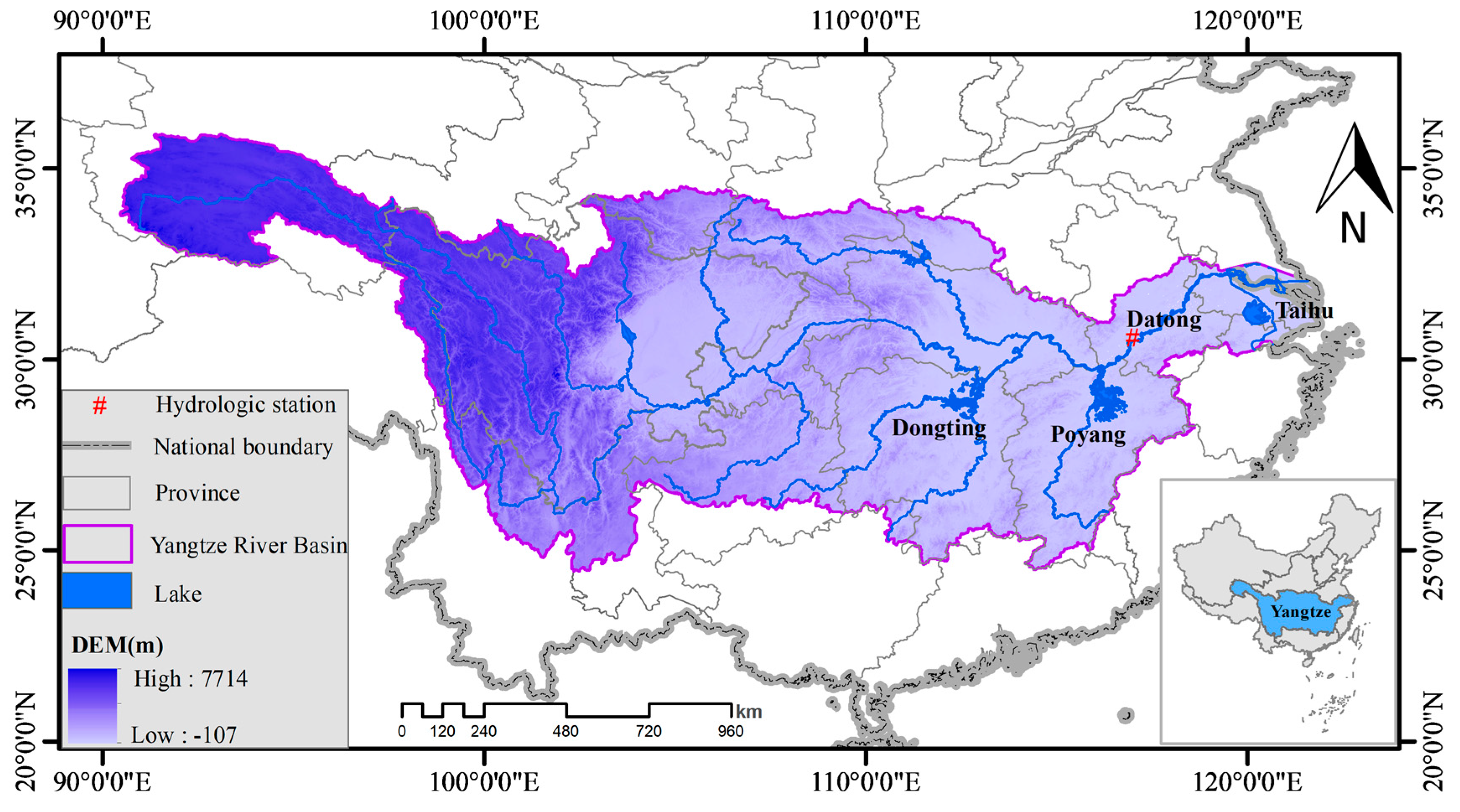


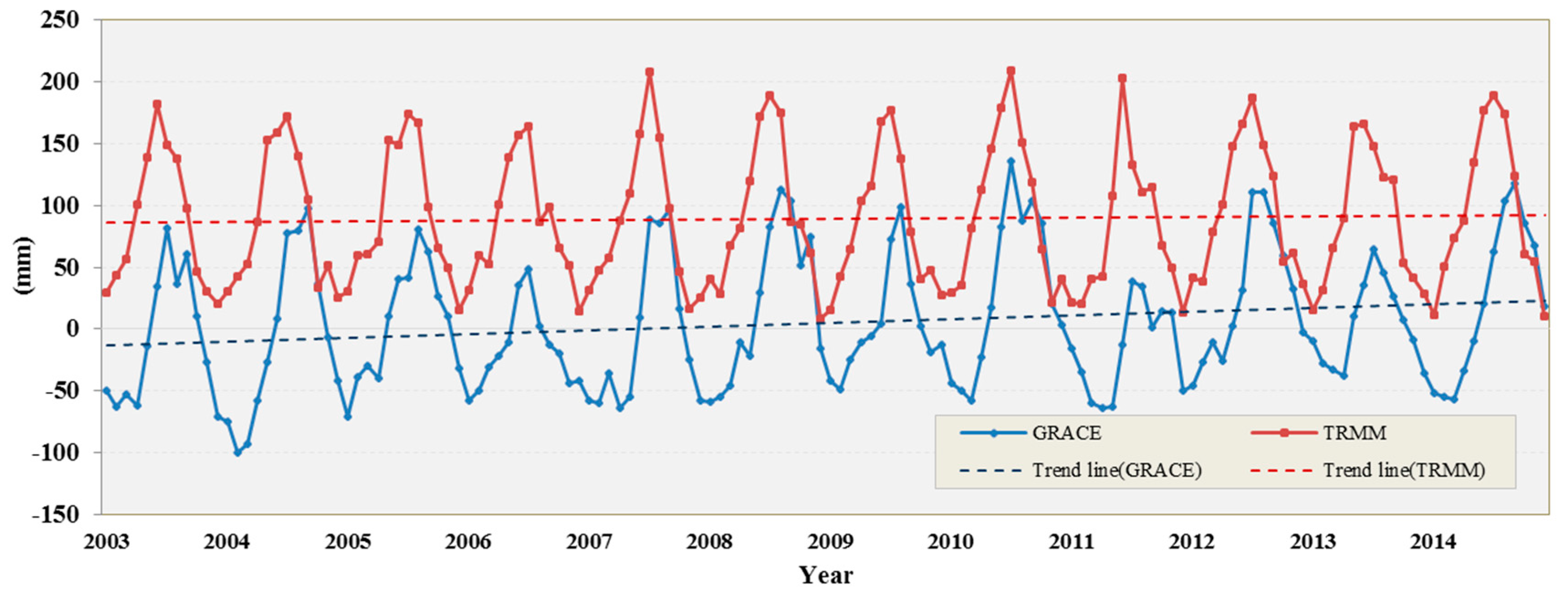

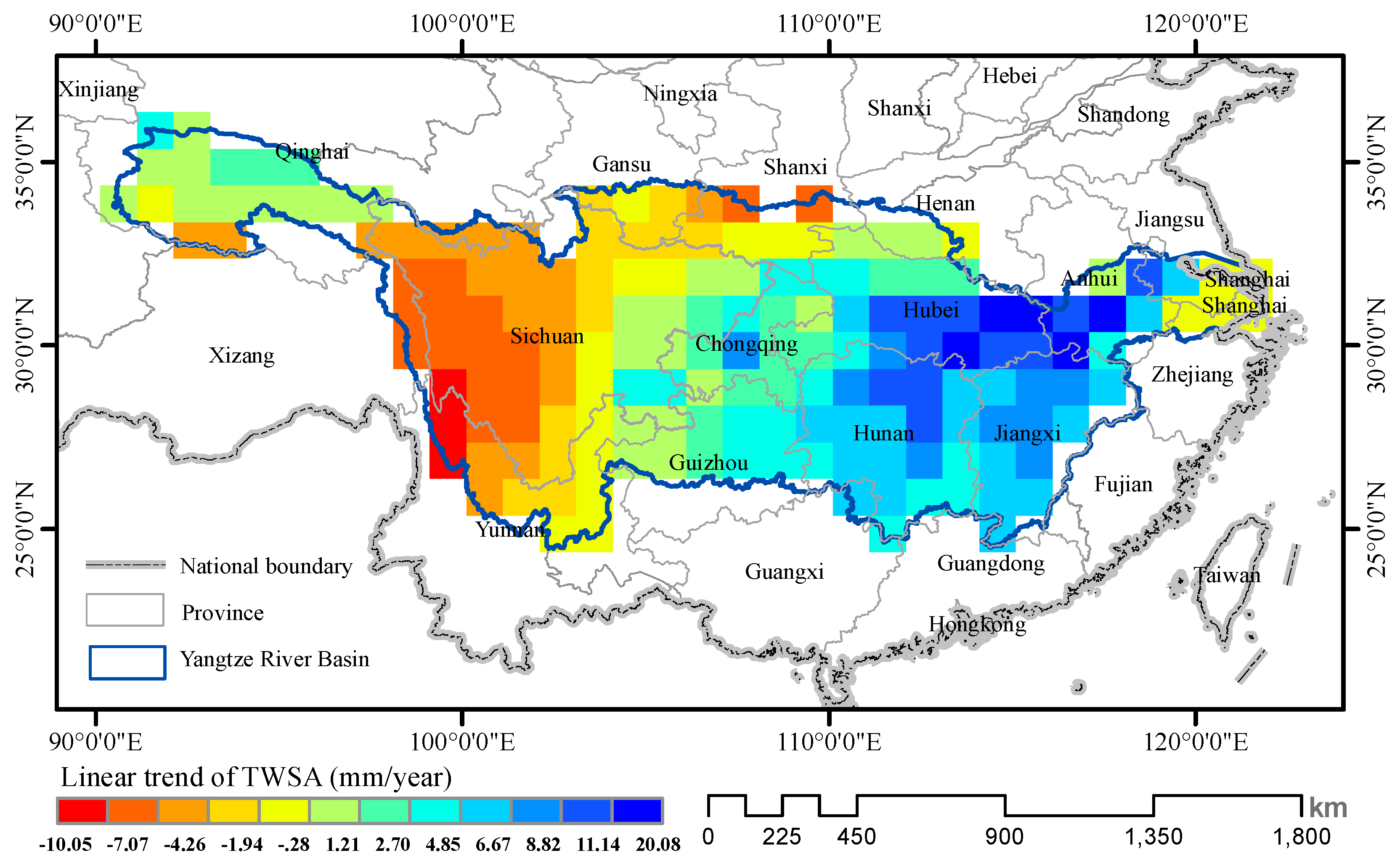

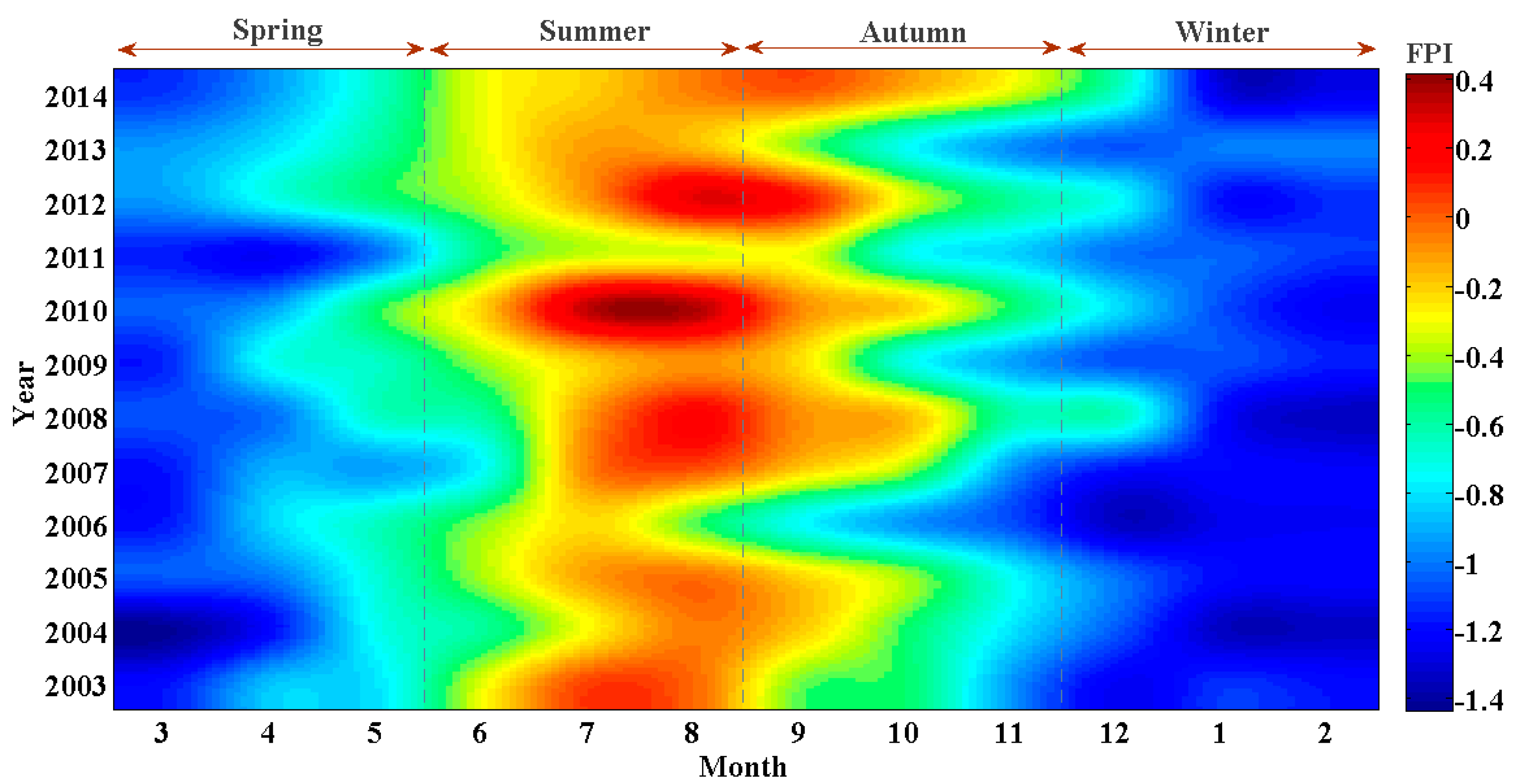

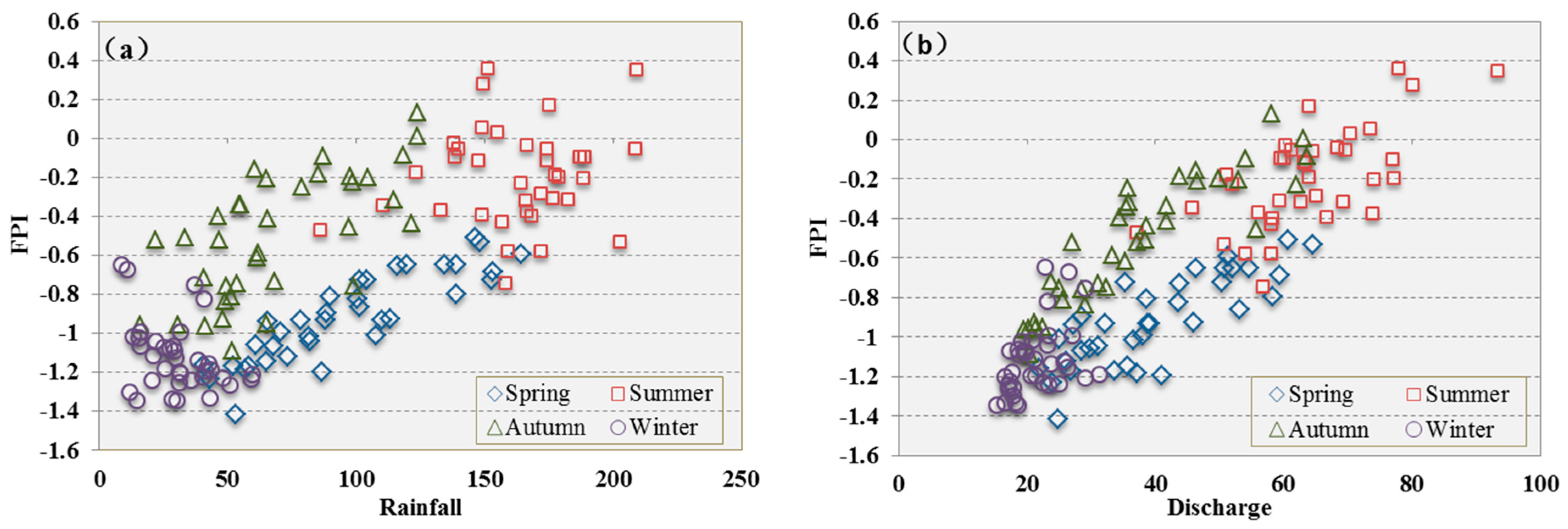
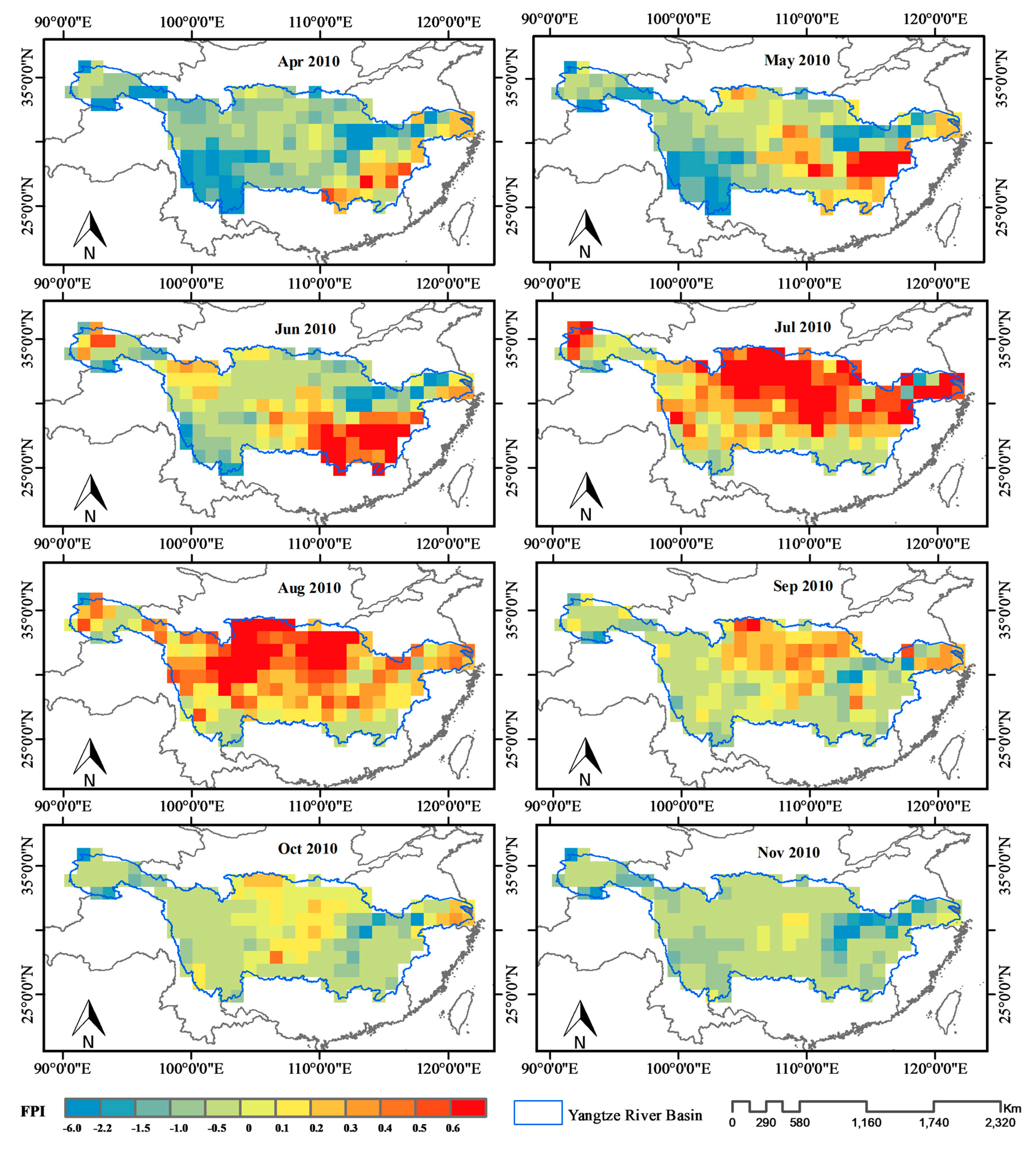
| No. | Time | FPI | Discharge/mm(Percent of Greater than Monthly Mean Discharge) | Rainfall/mm(Percent of Greater than Monthly Mean Precipitation) |
|---|---|---|---|---|
| 1 | July–August 2010 | 0.36 | 93.32 (37.95%) | 209.03 (19.44%) |
| 2 | August–September 2012 | 0.28 | 80.10 (29.75%) | 149.30 (4.94%) |
| 3 | August 2008 | 0.17 | 64.00 (3.67%) | 175.17 (23.12%) |
| 4 | July 2003 | 0.05 | 73.64 (18.50%) | 148.82 (−14.96%) |
| 5 | August 2007 | 0.03 | 70.46 (14.13%) | 154.94 (8.91%) |
| 6 | September 2014 | 0.01 | 63.08 (27.27%) | 123.66 (17.38%) |
© 2017 by the authors. Licensee MDPI, Basel, Switzerland. This article is an open access article distributed under the terms and conditions of the Creative Commons Attribution (CC BY) license (http://creativecommons.org/licenses/by/4.0/).
Share and Cite
Sun, Z.; Zhu, X.; Pan, Y.; Zhang, J. Assessing Terrestrial Water Storage and Flood Potential Using GRACE Data in the Yangtze River Basin, China. Remote Sens. 2017, 9, 1011. https://doi.org/10.3390/rs9101011
Sun Z, Zhu X, Pan Y, Zhang J. Assessing Terrestrial Water Storage and Flood Potential Using GRACE Data in the Yangtze River Basin, China. Remote Sensing. 2017; 9(10):1011. https://doi.org/10.3390/rs9101011
Chicago/Turabian StyleSun, Zhangli, Xiufang Zhu, Yaozhong Pan, and Jinshui Zhang. 2017. "Assessing Terrestrial Water Storage and Flood Potential Using GRACE Data in the Yangtze River Basin, China" Remote Sensing 9, no. 10: 1011. https://doi.org/10.3390/rs9101011
APA StyleSun, Z., Zhu, X., Pan, Y., & Zhang, J. (2017). Assessing Terrestrial Water Storage and Flood Potential Using GRACE Data in the Yangtze River Basin, China. Remote Sensing, 9(10), 1011. https://doi.org/10.3390/rs9101011




